This, dear readers, is why my Robes & Robings project is going to be hopelessly late:

I’m not supposed to be taking commissions at the moment, as I’m working more than full-time between teaching at uni and teaching sewing, and trying to run the HSF and work on other projects. But when Rowena, who I’ve worked with before, contacted me to see if I would make her an 1840s inspired evening dress to wear at a parlour concert set in the 1840s, how could I resist?
I’m such a sucker for a pretty dress idea!
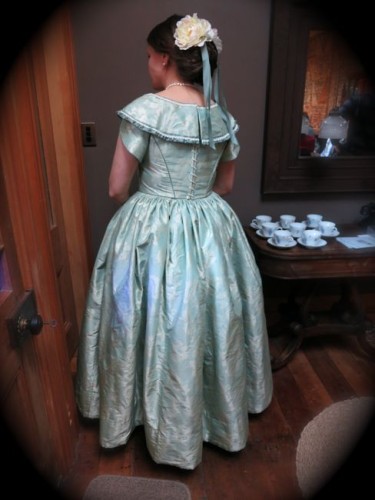
And Rowena is such a delight to work with, which made taking on a commission very easy. We only had a month and a bit to make the dress in, but luckily we were able to find a fantastic pure silk jacquard in Wellington, and once the right fabric was found, the project just sailed ahead.
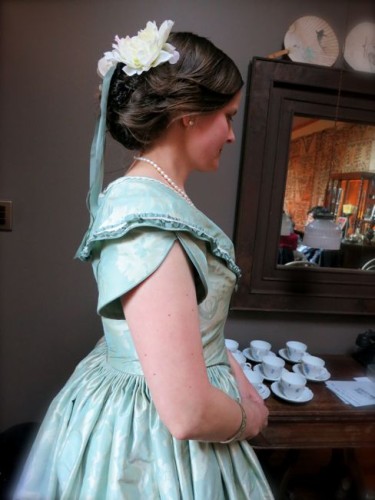
Sea green was very fitting for this project, as the parlour concert’s programme included Haydn’s Lines from the Battle of the Nile, the Mermaid’s Song and the Sailor’s Song and finished with Steibelt’s Britannia: An Allegorical Overture (which is, by the way, quite possibly the most hilarious piece of classical music ever written).
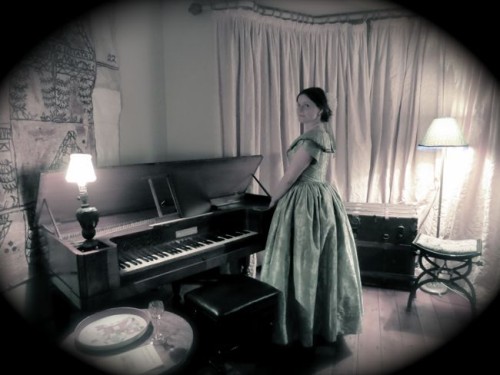
All of the musical numbers featured dated from the turn-of-the-nineteenth century (Lines was commissioned, and first sung, by Lady Hamilton to commemorate Nelson’s victory), but Rowena requested an 1840s dress, because it would match the 1843 piano. The piano, an English square piano, has been in New Zealand since the 19th century, and it’s quite possible that it performed Haydn’s compositions when it was newly made.
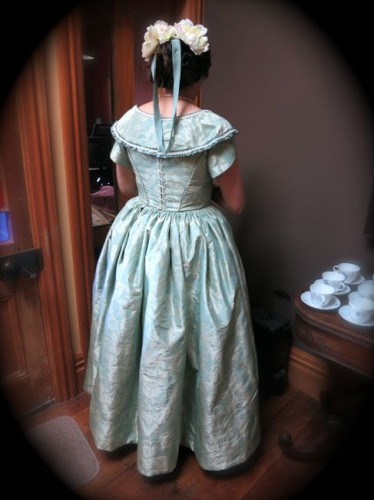
I’m calling the dress 1840s inspired, rather than a reproduction, because we made some compromises because of time and budget constraints, and in order to make it more comfortable for Rowena to sing and move in. The pattern is reasonable accurate, but it is cut to be worn without a corset, and is quite lightly boned. It’s also almost entirely machine sewn, as I didn’t have time to hand-sew it. The cartridge pleats are worked by hand, as are the lacing holes, as metal eyelets (while they did exist in the 1840s) would never have been used on anything but undergarments.
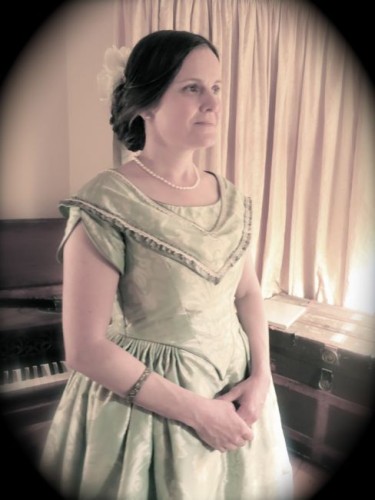
Despite the anachronistic machine sewing, I tried to keep the construction as authentic as possible. Every seam, including the armhole, is piped in tiny piping, I paired the sea green brocade with a darker jade green silk for piping and trim.
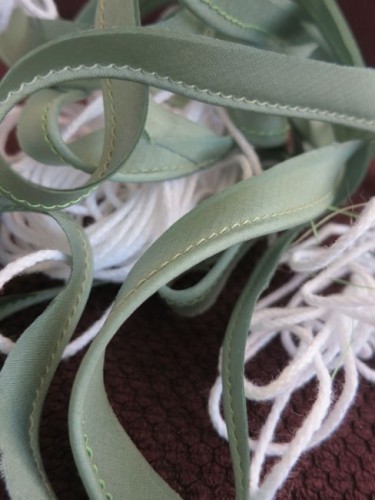
The whole frock was an elaborate exercise in pattern matching, and extremely careful cutting. I got the entire dress out of 2.7m of the 145cm wide silk – every scrap that there was to be had in Wellington.
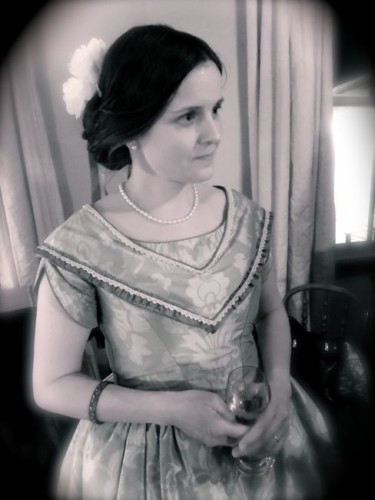
You may be wondering what exactly a parlor concert (or soiree) is? It’s just what it sounds like: a small, intimate concert held in the parlor of a private home.

This one was held in the home of the pianist, who has as many pianos (and piano variants such as harpsichords) as I have sewing machines, and a whole lounge set aside just to house them and hold soirees in. What delicious luxury! The house is amazing: full of old furniture and books, authentic to its Victorian roots while remaining both elegant and comfortable.
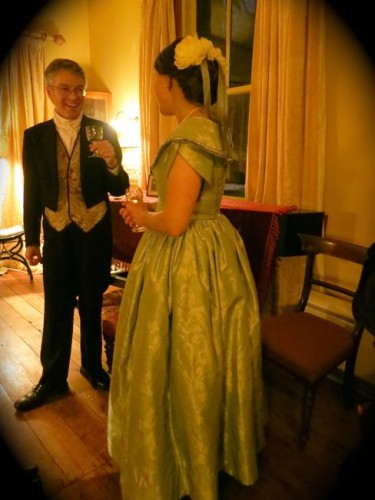
Parlor concerts are wonderful, because experiencing live classical music in such a small, intimate setting is a very different experience to a large concert hall. This one in particular felt as if I was attending a party in the 1840s where the musical celebrity guests did an impromptu performance. The performers mingled with the audience before and after the music, and the performance interacted with the audience in a way that just isn’t possible in a bigger setting. I love parlor concerts.
Also, I’m rather in love with Rowena in her frock. She just suits the period so perfectly!
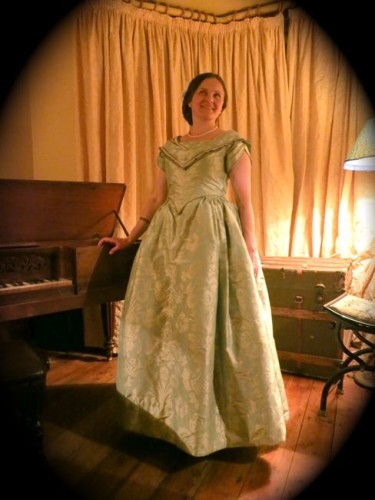
So I haven’t finished a robe, but I’m still pleased with myself!

I love the entire concept, and the dress is gorgeous!
Thank you Susie! I’m so pleased with how it came out – and how she looks in it!
I love the dress and the concept! That is a lot of commitment to a concert, to have such an accurate outfit made for it. The palaces here in Germany often advertise 18th century concerts with the musicians in period dress, but as far as I can tell from the posters, they are in cheap, inaccurate costumes. You mention adjustments for ease of singing; when I worked for an opera, they laced the corsets with elastic cord for a bit of extra give.
I was very impressed that Rowena was so committed to the idea! I even suggested being a little less historical – just aiming for the effect, but she was determined to go the full nine yards, with a berthe etc.
Oh…I’d forgotten about elastic cord! I’ve sewed some opera costumes in the past, and that is what we did. I find that some singers are comfortable being fairly snugly laced and still singing, and some aren’t, and you just have to work with that.
What a truly beautiful dress! I love the colour choice too!
I wonder if singers back then had adaptations made to their dresses to allow them to sing more easily?
I wish I could have heard her singing the songs, it sounds fabulous!
Only 2.7m! Wow! You are truly talented!
Thanks Laura! I can admit now that wasn’t sure about the colour myself, but Rowena was right, and it looks perfect in the room!
I’ve wondered about adaptations to dress for historical singers as well.
It was two just-over 1m lengths for the skirt, and then 60cm to get the bodice out of! Quite a puzzle to cut, but it worked out in the end!
Lovely! I particularly like that you found a jacquard rather than just a solid. It gives the dress a little more visual interest. I think it definitely achieved an air of the 1840s. Good job!
Best,
Quinn
Thanks Quinn! I was VERY pleased that we found that fabric. We looked at a lot of plain taffetas, but if it had been a solid fabric I really would have felt the need to do skirt decoration.
It’s so hard to find good patterns for historical sewing. I do think solids end up being a slight recreation-ism: overrepresented compared to the past.
Absolutely charming! What a lovely thing to have done – so pleasing. The whole dress is beautiful, but I especially love the little sleeves – so neat and so becoming.
Thanks Lynne! I’m quite pleased with the sleeves myself. They are a bit unusual, but I did find some examples of 1840s sleeves with petal shapes.
I’ve worked on film projects where the designer has insisted on bound seams on garments that will NEVER be seen, when a little of overlocking would keep things within budget – total nightmare. So, I understand the compromises you’ve sensibly made. Having said that, I think the bodice suffers slightly from lack of a good corset underneath, particularly in the bust area. Foundation garments really are the foundation of what sits on top.
Oh, I agree that corsets really make the shape – and make it so much easier to build a garment over. It’s far more work for me to make a historical gown that won’t be worn over a corset! However, with this dress it was far more important that the singer could breath and sing in the frock than the line of the fit. The bodice was originally snugger, and stiffer, but I ended up taking out boning and letting it out because it was making it hard for her. Everything to its purpose as it must be!
As a fellow classical musician I am drooling with jealousy. And also vast amounts of hooray-this-is-awesome-and-it-should-happen-more-often! What a great program, btw!
Oh, it was amazing! So fantastic! (and hurrah that someone recognizes the programme).
Any chance you could organise something similar? You just need someone with a large lounge that can be rearranged to seat lots of people, and space for performers, and a few performers. Historical dress an optional massive bonus!
Oh my… Your dress is absolutely gorgeous. It looks so pretty and elegant on you. Phantastic..
That’s not me in it, but thanks!
With the first photo, I thought of Mary Todd Lincoln who was a young belle at this time and who loved, loved finery and beautiful clothes. Her affinity for headdresses — flowers and so on — isn’t so becoming or interesting, to me, at least. She did have quite nice hair. Perhaps the ornaments were THE fashion.
You may have read the book by her dressmaker in the White House or other accounts.
I love knowing about the seams and the cutting!
It’s gorgeous, I just love that color. She must have been so thrilled!
I’m glad to see it worked out! 🙂 A) the result is beautiful, B) it means I can also do something similarly fabulous with such smallish amounts of fabric if I try… which I tend to do.
Plus, as Quinn said, great that you found a jacquard – I’ve seen enough 1840s jacquard dresses to think it’s the right look. 😉
Is Rowenna wearing some historical(ish) undergarments, if not a corset?
And the concert must have been a wonderful occasion. I can only imagine…
It’s so cool when artists get together and make something so special. Hooray!
I am so lucky to have had the talented Dreamstress to make this dress. Thank you, thank you, thank you! I especially love the detail in the bodice. And thank you for giving me room to breathe.
I’m sorry to say the undergarments were quite modern – maybe that’s something to work on for the next project 😉
Or maybe I mean the sleeves and the bertha, not the bodice. I definitely couldn’t have made it anyway!